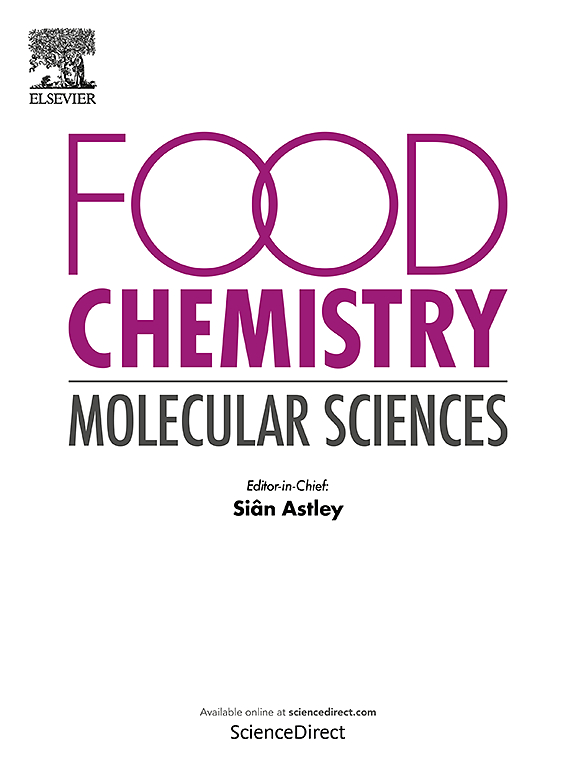希腊橄榄品种生产的橄榄油的遗传和化学分析:与脂肪酸组成和酚稳定性的遗传谱联系
IF 4.7
Q2 FOOD SCIENCE & TECHNOLOGY
引用次数: 0
摘要
这项初步研究探讨了橄榄品种的遗传谱与其油中单不饱和脂肪酸(MUFA)含量之间的关系,重点是氧化稳定性和酚完整性。我们的工作假设是MUFA含量的遗传变异直接影响关键酚类物质的氧化稳定性,特别是油酸和油酸。为了研究遗传聚类与油酸含量的关系,利用11个SSR标记对80个栽培条件下的希腊橄榄品种进行了基因分型,并用1H NMR对其脂肪酸组成进行了测定。用不同MUFA水平的油来测试酚稳定性。遗传分析确定了三个簇。化学聚类分析将品种划分为3个MUFA类,发现各类间差异显著。连接遗传和脂质谱组突出了显著的重叠。这项研究揭示了橄榄基质中MUFA丰度与其保持酚完整性的能力之间的明确实验关联。通过确认MUFA含量在橄榄油酚稳定性中的作用,我们的研究结果为早期品种选择和未来针对提高橄榄油品质的育种计划提供了基线参考。本文章由计算机程序翻译,如有差异,请以英文原文为准。
Genetic and chemical analysis of olive oil produced by Greek olive cultivars: Linking genetic profiles with fatty acid composition and phenolic stability
This pilot study explores the relationship between the genetic profiles of olive cultivars and monounsaturated fatty acid (MUFA) content of their oils, with emphasis on oxidative stability and phenolic integrity. Our working hypothesis was that cultivar-specific genetic variation in MUFA content, directly affects the oxidative stability of key phenolics, particularly oleocanthal and oleacein. To examine the association between genetic clustering and oleic acid content, eighty Greek olive cultivars cultivated under controlled nursery conditions were genotyped using eleven genomic simple sequence repeat (SSR) markers, and their fatty acid composition was determined by 1H NMR. Phenolic stability was tested using oils with contrasting MUFA levels. Genetic analysis identified three clusters. Chemical cluster analysis, by dividing cultivars into three MUFA classes, revealed significant differences among divisions. Linking genetic and lipid profile groups highlighted notable overlap. This study reveals a clear experimental association between MUFA abundance in the olive matrix and its capacity to preserve phenolic integrity. By confirming the role of MUFA content in phenolic stability, our results provide a baseline reference for early-stage cultivar selection and for future breeding programs targeting enhanced olive oil quality.
求助全文
通过发布文献求助,成功后即可免费获取论文全文。
去求助
来源期刊

Food Chemistry Molecular Sciences
Agricultural and Biological Sciences-Food Science
CiteScore
6.00
自引率
0.00%
发文量
83
审稿时长
82 days
期刊介绍:
Food Chemistry: Molecular Sciences is one of three companion journals to the highly respected Food Chemistry.
Food Chemistry: Molecular Sciences is an open access journal publishing research advancing the theory and practice of molecular sciences of foods.
The types of articles considered are original research articles, analytical methods, comprehensive reviews and commentaries.
Topics include:
Molecular sciences relating to major and minor components of food (nutrients and bioactives) and their physiological, sensory, flavour, and microbiological aspects; data must be sufficient to demonstrate relevance to foods and as consumed by humans
Changes in molecular composition or structure in foods occurring or induced during growth, distribution and processing (industrial or domestic) or as a result of human metabolism
Quality, safety, authenticity and traceability of foods and packaging materials
Valorisation of food waste arising from processing and exploitation of by-products
Molecular sciences of additives, contaminants including agro-chemicals, together with their metabolism, food fate and benefit: risk to human health
Novel analytical and computational (bioinformatics) methods related to foods as consumed, nutrients and bioactives, sensory, metabolic fate, and origins of foods. Articles must be concerned with new or novel methods or novel uses and must be applied to real-world samples to demonstrate robustness. Those dealing with significant improvements to existing methods or foods and commodities from different regions, and re-use of existing data will be considered, provided authors can establish sufficient originality.
 求助内容:
求助内容: 应助结果提醒方式:
应助结果提醒方式:


